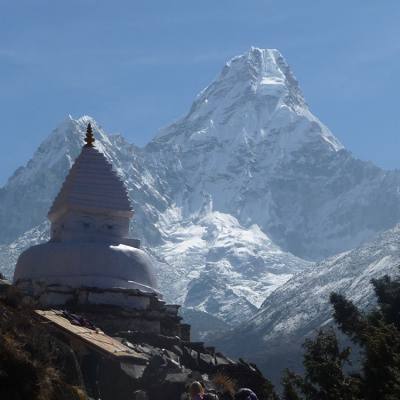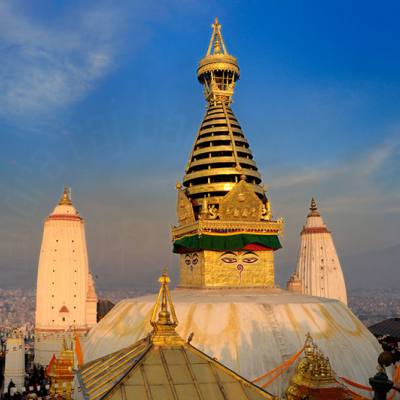During your tour, most of the monuments and cities offer so much of information that you could be overwhelmed. So, a little knowledge about the religion in Tibet could make you well prepared to digest all the information which you encounter step by step. Please read this section and make yourself well-prepared.
Buddhism
The origin of Buddhism is accredited to Lord Buddha. The Buddha is a title which means ‘the enlightened’ given to Siddhartha Gautama who was born in circa 600 B.C. as a prince in Lumbini (Nepal) around 295 km south-west of Kathmandu. He grew up in full luxury shielded from contact with human misery and agony. He got married young. One night curiosity led him outside the royal palace where he encountered with the mind boggling examples of disease, old age and death. Ultimately, fully determined to find a way to save mankind from suffering he renounced his royalty, whole family including his beautiful wife and young son at the early age of 29. He spent long, long years wandering as an ascetic and eventually, fasting and meditating under a tree, he received enlightenment.
Buddha’s insight into ultimate reality presented the four noble truths with the eightfold path to nobility. He always presented himself as a guide, never as an authority. In other words, Buddhism in its early days was taken as a way of life, not as a religion. This way, Buddha’s followers formed open communities of monks and nuns living a disciplined life and sought wisdom: their prime virtue. In the 3rd century B.C., the early form of Buddhism later called Theravada took root in Sri Lanka and spread onto other parts of south and south-east Asia.
In course of time, a new form of Buddhism called Mahayana (literally meaning Great Vehicle) evolved from Theravada appeared in around 1st century A.D. Centering on the intellectual problem of being, it focuses on a gradual but ultimately complete understanding of a well-established body of spiritual knowledge. The Mahayana ideal is the Bodhisatwa (not the Buddha), a person who seeks enlightenment not for his own sake but for the salvation of all living beings. He delays entry into Nirvana, the final escape from the vicious cycle of existence, in order to save others from suffering. Mahayana Buddhism spread to central Asia (Afganistan, Pakistan, India & Nepal), China, Korea and Japan.
A third type of Buddhism: Tantrism (synonym of Vajrayana: the ‘Diamond Vehicle) evolved in around 2nd or 4th century A.D. in India & Sri Lanka. It focuses on existential problems. Philosophically, it follows Mahayana precepts, but in practice, the student of Tantra is able to achieve enlightenment through a calibrated process of meditation under the guidance of an initiated teacher. Mahayana looks at Being, whereas Tantrism acts through Being.
Tibetan Buddhism is a synthesis of two major Buddhist systems: Mahayana & Tantrism. From the 7th century onward, Buddhism got introduced in Tibet with the full efforts of religious kings by inviting the renowned Indian masters like Padma Sambhava, Atisha and so on. They encouraged a vigorous campaign of translation of sacred Sanskrit texts into Tibetan & at the same time the building of many temples. As a result, in around 14th century, having access to all relevant Buddhist texts the Tibetan students congregating around various charismatic masters, evolved rival sects with distinctive schools from time to time, each with its own style and emphasis.
Main Sects of Tibetan Buddhism
Nyingmapa
The Nyingmapa is the old school sect, founded during the first diffusion of Buddhism in around 750 A.D. Its first and major proponent was Padma Sambhava (Guru Rimpoche). The sect holds that there are nine paths to enlightenment. The first three are based on the sutras and the other six on the tantras. Nyingmapa monks often marry and work individually in a small village chapels and remote caves. Mindroling Monastery, Dorje Drak Monastery and Samye Monastery are its major monasteries in Tibet.
Sakyapa
The school was named after its principal monastery called Sakya Monastery (which governedfounded during the second diffusion of Buddhism in around 11th century. Hevjra Tantra written by the Indian tantric sage Birupa (translated by a Tibetan master Drokmi Lotsawa) is the basic text of the Sakyapa. Sakyapa teaching integrates the precepts of sutra and tantra into a discipline designed to bring about Buddhahood in a single lifetime.
Kagyupa
Kagyu means ‘orally transmitted precepts’. Kagupa places fundamental emphasis on the direct transmission of esoteric teachings from master to pupil. It rose in 1060 A.D. with the master teachers Tilopa, Naropa, Marpa & Milarepa. The Kagyu system focuses strongly on aspects of practical mysticism, a basic discipline emphasizing on Hatha Yoga, which specializes in breathing techniques and postures. Under this system, to achieve enlightenment within a lifetime, or at the momentof death, the practictioner relies on the six Yogas of Naropa (self-produced heat, illusory body, dreams, experience of light, intermediate state between deathand rebirth, passing from once existence to another).
Kadampa
The chief proponent of Kadam (Bound by Precepts) school was Atisha. Under Kadampa, students observed four fundamental rules: celibacy, abstinence form intoxicants, prohibition of travel and money handling. The central practice is a process leading to a clear perception of emptiness through the purification of mind, purging of all intellectual and moral shortcomings. Its primary text is Pranjnparmita (Perfection of discourses) and its major centers were Reting, Langtang and Sangphu.
Gelugpa (Yellow Hat Sect)
The Gelug (Virtuous Ones) is the Tibet’s reformed sect. Tsong Khapa (1357-1419), it founder, propogated his new Tibetan Buddhism with a thorough study of Sakya, Kadam and Kagyu teachings. In fact, Gelugpa is the continution of Kadampa enunciated by Atisha. The new sect was partially a reaction against the moral laxity of the era. Tsong Khapa imposed rigorous devotion to the traditional rules of the monastery and students were supposed to master dogmatics and logic through an intensive study of texts and methodical practice as a means ot Buddhahood. The sect dominated Tibet after the 17th century allowing other sects to play a minor role.

 98510 22507 (Mahendra)
98510 22507 (Mahendra)




